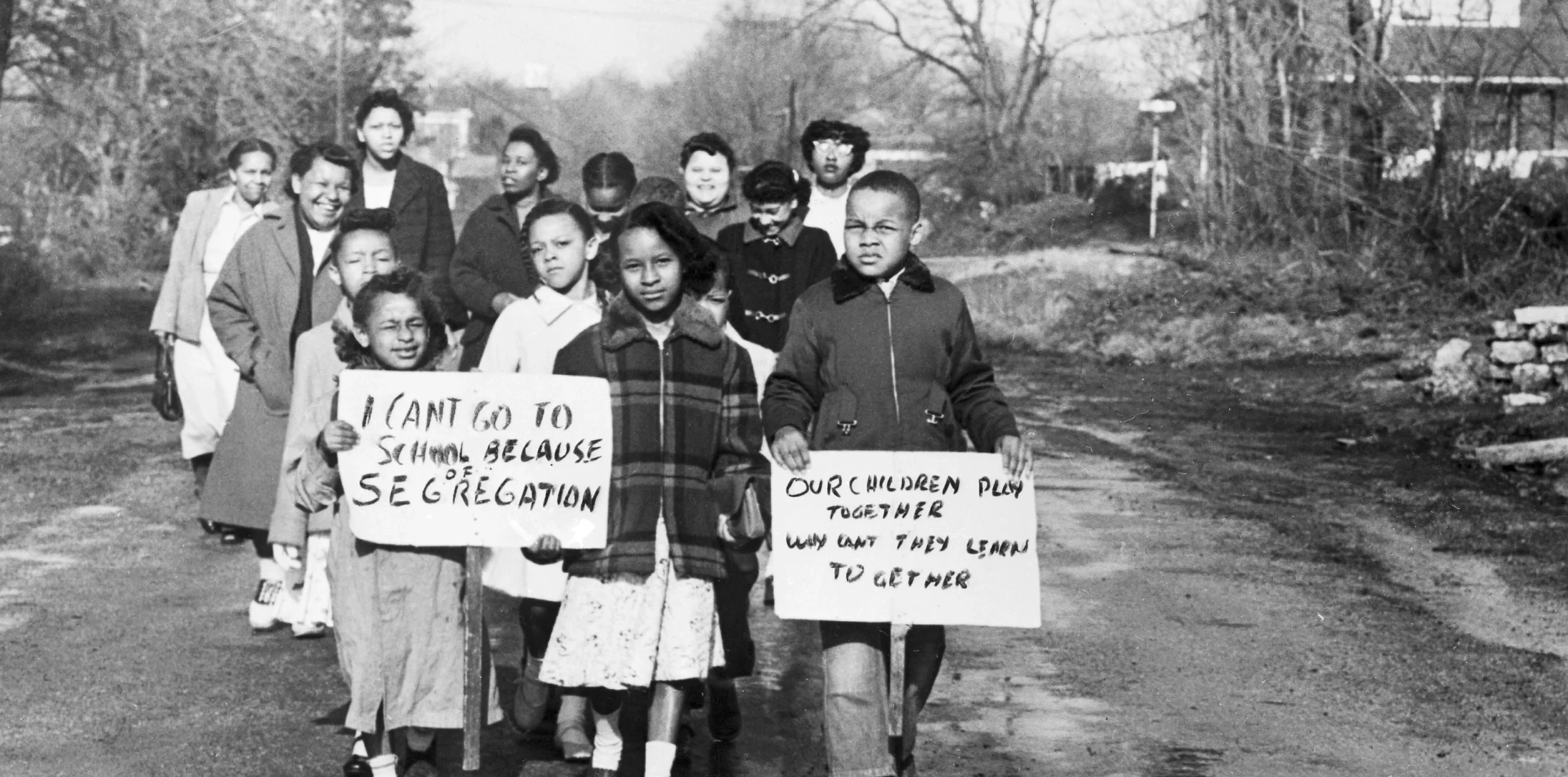Photo by Bettmann Collection/Getty Images
Threatened by imprisonment and tormented by racial epithets and a burned cross, schoolchildren marched for integration. Despite conjuring images of the Deep South, this happened in a small Ohio town two years after Brown v. Board of Education (1954) was supposed to have ended school segregation.
Newspapers nicknamed Hillsboro “little dixie,” but in truth the town wasn’t unique. Hillsboro’s all-white school board stalled on desegregating its schools like nearly all schools across the nation.
The actual work of integration fell on Black students and parents. The puddles of water underscore that rain or shine, every morning for two years mothers and children marched for education equality in this tiny Ohio town.
In 1954, all of Hillsboro’s seventy Black elementary students attended Lincoln School. Many had to walk past the all-white schools, Washington and Webster, to reach Lincoln, the all-Black school. In a nearly century-old building where snow blew inside in the winter, six grades shared two rooms, two teachers, and books discarded from white schools.
A fire—set by a white man in a misguided effort to end segregation—badly damaged Lincoln that summer but did nothing to convince the school board to integrate. Classrooms were freshly painted, but Black parents feared the building might collapse.
The state’s first public schools only allowed funding for “white youths.” In 1848, Black Ohioans won the right to be taxed for the education of Black children. After another hard fight, the state repealed a provision allowing segregation in 1887. A Black father in Oxford, Ohio tested this in court that same year and won. Similar battles continued and courts repeatedly reaffirmed that Ohio’s laws banned segregation.
Nevertheless, many Ohio schools remained segregated. By 1954, the fight for integrated education was over a century old and school segregation had been illegal in the state for 70 years. Hillsboro’s schools, segregated since at least 1869 when Lincoln opened, formalized segregation in 1939.
The summer after Brown, Imogene Curtis, Gertrude Clemons, and several other mothers started a petition demanding integration of Lincoln’s students and teachers into Washington and Webster. When they delivered it with nearly all Black Hillsboro residents’ signatures, a board member insisted they were “asking the impossible.”
Undeterred, 50 Black students accompanied by their parents presented themselves at Washington and Webster on the first day of school. Segregation seemed like it might come to an anticlimactic end as they were enrolled and assigned classrooms.
Within days, however, under the guise of overcrowding, the school board redrew district lines. The resulting map, which officials refused to show in court, had been so gerrymandered that only a handful of Black children were assigned to Washington and Webster. Lincoln remained all-Black. White students, a board member later told the court, would be insulted if assigned to Lincoln.

Unwilling to accept this charade, the mothers began marching their children to Washington and Webster each day only to be rebuffed. Blinds were tightly drawn to prevent white students from seeing as their would-be classmates were turned away. The school board threatened to arrest the mothers if the “truant” children didn’t enroll at Lincoln. But the mothers refused to send their children to a school they feared structurally unsound and instead homeschooled their children with assistance from a nearby Quaker college.
The situation attracted the attention of the NAACP, which brought a case against the district in September 1954. Constance Baker Motley, who worked on the Brown decision, served as lead council, and Thurgood Marshall led oral arguments one day. The judge insisted the case was “premature” as the Supreme Court had not yet provided a timetable for Brown. After the Supreme Court urged schools to comply with “all deliberate speed” in 1955, the judge continued to stall.
Every delay meant another morning march for some 20 mothers and 40 children. Throughout the 1954-55 and 1955-56 school years they marched every day without fail.
The photo captures the image of these brave mothers and their children. But in its silence, we cannot hear the racial epithets hurled at them as they marched or the threats mothers received from white employers. One child’s sign asks, “Our children play together / Why can’t they learn together,” but the children recalled being rejected by would-be white playmates.
The marching mothers changed their route after white construction workers exposed themselves to the kids. But when a cross was burned in a Black family’s yard, they maintained their path past the charred remains.

On April 2, 1956 the Supreme Court declined to review the decision of a lower court siding against the school board. That night, Imogene Curtis waited hours at a school board meeting to ask about getting the children placed in the appropriate grades immediately. The board postponed their decision until fall. The marching continued.
This picture was taken the morning after that school board decision. Except for the increased press presence, the march occurred much as it had every day of the long two years. On April 11, the school board voted to integrate only after the Ohio Board of Education, weary of growing press attention, threatened to withhold state funding.
On April 17, 1956, the children were finally allowed to enter their classrooms at Washington and Webster. A local editorial claimed the mothers hurt their children by their actions, but Imogene Curtis retorted: “Many of our people died freeing us and our descendants, but it didn’t make the victory any worse.”
Once national attention drifted away, Hillsboro’s schools devised new ways to thwart integration. Students who protested were held back two grades in what their parents believed was punishment for their activism. White teachers glared at their new pupils, white students largely avoided them, and they were bored in grades behind where they should have been. Only recently has the town started to commemorate instead of hiding this history.
Brown receives a lot of praise for ending school segregation. But the ruling didn’t make it a reality. Black students and parents’ actions, sacrifices, persistence, and continuing fight today gave Brown meaning. The burden of enforcement was borne on the backs (and marching feet) of Hillsboro students and parents in what became the first northern test case of the Brown decision.
As parents nationwide lament the year of remote education from the COVID-19 pandemic, they should keep in mind that in Hillsboro, OH, Farmville, Virginia, and many other places, Black students endured remote education long before Zoom in order to fight for equality.

Listen to the author:
Learn more:
Sarah Stankorb, “The Long Walk” The Atavist Magazine (June 2020)
Andrea Torrice, “The Lincoln School Story—A Battle for School Integration in Ohio,” [Film] (2017)
Pat Williamsen, “Fire of Justice: The Battle for School Desegregation in Hillsboro” (Spring 2017)
Special thanks to Kati Burwinkel, Project Director of the Lincoln School Exhibit





